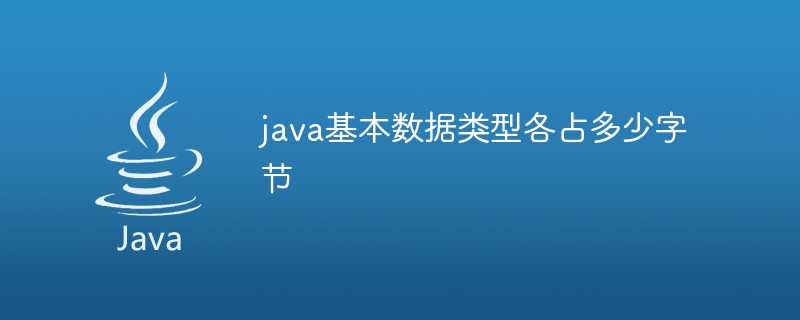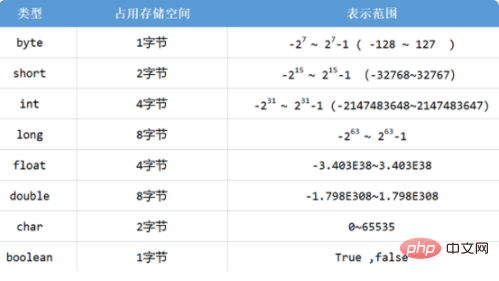
Java has a total of 8 basic data types: 1. Int occupies 4 bytes, and the value range is "-2147483648~2147483647"; 2. Short occupies 2 bytes, and the value range is "-32768~ 32767"; 3. long occupies 8 bytes; 4. byte occupies 1 byte, and the value range is "-128~127"; 5. float is a single floating point type, occupies 4 bytes; 6. double is double float Point type, occupies 8 bytes; 7, char occupies 2 bytes; 8, boolean occupies 1 byte.

The operating environment of this tutorial: windows7 system, java8 version, DELL G3 computer.
About Java’s 8 basic data types, their names, digits, default values, value ranges and examples are shown in the following table:

Integer type
Among them, byte, short, int, and long all represent integers, but their value ranges are different
The value range of byte is -128~127, occupying 1 byte (-2 to the 7th power to the 7th power of 2 -1)
The value range of short is -32768~32767, occupying 2 bytes (-2 to the 15th power to 2 to the 15th power -1)
int The value range is (-2147483648~2147483647), occupying 4 bytes (-2 to the 31st power to 2-1). The value range of
long is (-9223372036854774808~9223372036854774807), occupying 8 bytes (-2 to the 63rd power to 2 to the 63rd power -1).
You can see that the value range of byte and short is relatively small, while the value range of long is too large and takes up a lot of space. Basically int can meet our daily calculations. , and int is also the most commonly used integer type.
Under normal circumstances, if an integer number such as 35 appears in JAVA, then this number is of int type. If we want it to be of byte type, we can add a capital B after the data: 35B , indicating that it is of byte type.
Similarly, 35S represents short type, and 35L represents long type. If it represents int, we can add nothing, but if we want to represent long type, we must add "L" after the data.
Floating point type
float, 4 bytes (, -3.4e 38 ~ 3.4e 38, 0.0f, Float
The float type value has a suffix F (for example: 3.14F)
double, 8 bytes, -1.7e 308 ~ 1.7 e 308, 0, Double
Floating point value without suffix F (for example: 3.14) defaults to double
The double type has a larger storage range and precision than the float type Higher, so usually floating-point data is of double type without declaration. If you want to indicate that a data is of float type, you can add "F" after the data.
Float Point type data is not completely accurate, so sometimes the last few decimal places may fluctuate during calculation. This is normal.
Character type
The data type used to store characters, occupies 2 bytes, uses unicode encoding, and its first 128 bytes of encoding are compatible with ASCII
The storage range of characters is \u0000~\uFFFF, in the definition When using character data, be careful to add ' '. For example, '1' means the character '1' instead of the value 1.
char c = ' 1 ';
Let's try to output c and see, System.out.println(c); the result It is 1, and if we output it like this System.out.println(c 0);
the result becomes 49.

Boolean
boolean, 1 byte, true false, FALSE, Boolean
For more related programming knowledge, please visit:Programming Learning Website!!
The above is the detailed content of How many bytes do each of Java's basic data types occupy?. For more information, please follow other related articles on the PHP Chinese website!